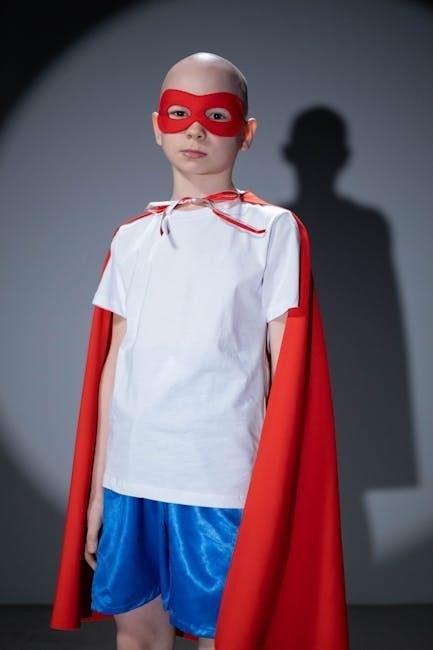boundaries henry cloud pdf
Dr. Henry Cloud’s Boundaries is a life-changing guide to understanding and implementing healthy limits. Co-authored with Dr. John Townsend, it offers practical advice on setting boundaries to reduce stress, improve relationships, and gain control over your life. Available as a PDF, audiobook, and video curriculum, it’s a must-read for personal growth.
Overview of the Book
Boundaries: When to Say Yes, When to Say No to Take Control of Your Life by Dr. Henry Cloud and Dr. John Townsend is a transformative guide to understanding and implementing healthy boundaries. The book provides practical examples and tools to help readers establish and maintain limits in their personal and professional lives. It emphasizes how boundaries are essential for fostering healthier relationships, reducing stress, and achieving emotional well-being. The authors offer clear, actionable advice on how to communicate boundaries effectively and maintain them in challenging situations. Available in various formats, including PDF, audiobook, and video curriculum, the book has become a go-to resource for individuals seeking to improve their lives. Its concise and accessible approach makes it a valuable tool for anyone looking to take control of their relationships and personal growth.
Importance of Boundaries in Modern Life
Establishing healthy boundaries is crucial in today’s fast-paced, interconnected world. They help individuals protect their time, energy, and emotional well-being, fostering balance and reducing stress. Without clear limits, modern life can become overwhelming, leading to burnout and strained relationships. Boundaries empower people to prioritize their needs, communicate effectively, and maintain mutual respect in personal and professional interactions. In a world where technology blurs work and personal life, setting boundaries is essential for sustaining mental and physical health. Dr. Henry Cloud emphasizes that boundaries are not about isolation but about creating a framework for healthier, more fulfilling relationships. By learning to say “yes” and “no” appropriately, individuals can regain control of their lives and thrive in a demanding environment. This principle is timeless and universally applicable, making it a cornerstone of personal growth and emotional intelligence in modern society.

Henry Cloud’s Expertise in Relationships

Dr. Henry Cloud is a renowned psychologist and leadership expert, widely recognized for his insights into relationships and personal development. His work, particularly in co-authoring Boundaries, has made him a trusted authority on establishing and maintaining healthy limits. With a deep understanding of human behavior, Cloud provides practical, biblically-based advice that resonates with diverse audiences. His expertise spans personal, professional, and romantic relationships, offering solutions to common challenges. Cloud’s approach emphasizes mutual respect, clear communication, and emotional well-being, making his guidance invaluable in today’s complex social dynamics. His books, including Boundaries in Marriage and Boundaries in Dating, have helped millions navigate relationship struggles. By blending psychological principles with real-life examples, Cloud equips readers with tools to build stronger, more fulfilling connections. His work continues to be a cornerstone for those seeking to improve their relational health and overall life satisfaction.
Key Concepts in Boundaries
Henry Cloud’s work emphasizes that boundaries are essential for protecting personal limits, fostering mutual respect, and promoting emotional well-being. They prevent burnout and create healthier, more balanced relationships. Boundaries are not about controlling others but about self-care and clarity in interactions. By setting clear limits, individuals can maintain their identity, reduce stress, and build stronger connections. Cloud’s teachings highlight the importance of communication, consistency, and consequences in enforcing boundaries effectively. His insights are widely applicable, from personal relationships to professional settings, offering practical tools for achieving emotional and mental health. The Boundaries PDF and related resources provide accessible guidance for implementing these principles in daily life.
Definition and Significance of Boundaries
Boundaries, as defined by Henry Cloud, are personal limits that protect one’s time, energy, and emotional well-being. They are essential for maintaining healthy relationships and fostering self-respect. Boundaries are not about controlling others but about taking responsibility for oneself. They can be physical, emotional, or mental and serve as a clear definition of where one person ends and another begins. Without boundaries, individuals risk burnout, resentment, and emotional exhaustion. Cloud emphasizes that boundaries are a form of self-care and respect for others, creating a foundation for mutual understanding and trust. They also promote personal growth by allowing individuals to focus on their priorities and values. The Boundaries PDF and related resources provide practical tools for understanding and implementing these limits effectively. By establishing boundaries, people can build stronger, more balanced relationships and achieve emotional and mental well-being.
Why Boundaries Are Essential for Healthy Relationships
Boundaries are vital for fostering healthy relationships, as they establish mutual respect, trust, and emotional well-being. Without clear limits, relationships often become strained, leading to resentment and burnout. Henry Cloud emphasizes that boundaries prevent emotional exhaustion by protecting one’s time, energy, and mental space. They also promote personal growth by allowing individuals to focus on their priorities and values. Healthy boundaries encourage open communication, reducing misunderstandings and conflicts. They create a safe environment where both parties feel valued and respected. Cloud highlights that boundaries are not about controlling others but about taking responsibility for oneself. This fosters a balanced relationship dynamic, where each person’s needs are acknowledged. The Boundaries PDF and related resources provide practical guidance on implementing these limits effectively, ensuring stronger, more fulfilling connections in all areas of life.
How to Set and Communicate Boundaries Effectively
Setting and communicating boundaries effectively requires clarity, consistency, and courage. According to Henry Cloud, boundaries should be specific and clearly defined to avoid misunderstandings. Start by identifying your limits and prioritizing what matters most. Communicate your boundaries calmly and assertively, using “I” statements to express your feelings without blaming others. For example, say, “I feel overwhelmed when…” instead of “You always….” Consistency is key; reinforce your boundaries by following through on consequences when they are crossed. This builds trust and respect. Cloud also advises practicing boundary-setting in low-stakes situations to build confidence. Additionally, listen to others’ boundaries and respect them, fostering mutual understanding. The Boundaries PDF and related resources offer practical exercises and examples to help you master these skills, ensuring healthier, more balanced relationships in all areas of life. By taking these steps, you can establish boundaries that protect your well-being while strengthening your connections with others.
Maintaining Boundaries in Challenging Situations
Maintaining boundaries in challenging situations requires resilience and emotional intelligence. Henry Cloud emphasizes that boundaries are not about controlling others but protecting your own emotional and mental well-being. When faced with resistance or pushback, stay calm and reaffirm your limits without guilt. Cloud suggests using phrases like, “I understand this is difficult, but I cannot compromise on this.” Consistency is crucial, even when it feels uncomfortable. For instance, if a friend repeatedly disregards your time, politely but firmly remind them of your boundaries. The Boundaries PDF and workbook provide practical exercises to help navigate such scenarios. Additionally, Cloud advises setting clear consequences for boundary violations, ensuring others understand the importance of respecting your limits. By staying firm yet compassionate, you can maintain healthy boundaries even in the most challenging situations, fostering respect and mutual understanding in all relationships.

Related Works by Henry Cloud
Henry Cloud’s Boundaries series includes Boundaries in Marriage, Boundaries with Kids, and Boundaries in Dating. The Boundaries Workbook offers practical exercises, while the Boundaries PDF provides accessible reading. These resources expand on his boundary-setting principles, helping readers apply them across various life areas.
Boundaries in Marriage
Boundaries in Marriage by Dr. Henry Cloud and Dr. John Townsend focuses on applying boundary principles to marital relationships. It explores how clear limits foster mutual respect, intimacy, and emotional safety. The book addresses common challenges, such as resolving conflicts and balancing independence with togetherness. By setting healthy boundaries, couples can prevent resentment and build a stronger, more fulfilling partnership. Practical examples and real-life scenarios help readers understand how to communicate their needs effectively. This guide is part of the Boundaries series, offering tailored advice for married individuals seeking to enhance their relationship dynamics. Available in PDF and other formats, it’s a valuable resource for couples aiming to create a harmonious and lasting marriage. The book emphasizes that boundaries are not about separation but about creating a foundation of trust and understanding, essential for a thriving marital bond.
Boundaries with Kids
Boundaries with Kids by Dr. Henry Cloud and Dr. John Townsend provides essential guidance for parents on teaching children about healthy limits. The book emphasizes the importance of setting clear boundaries to help kids develop self-control, responsibility, and respect for others. It addresses common challenges, such as discipline, entitlement, and emotional well-being, offering practical strategies to foster independence and maturity. By establishing boundaries, parents can create a safe and structured environment that promotes healthy development. The authors share real-life examples and actionable advice, making it easier for parents to implement these principles. Available in PDF and other formats, Boundaries with Kids is a valuable resource for families seeking to raise confident, capable, and compassionate children. The book highlights how boundaries are not about restriction but about empowering kids to thrive in life.
Boundaries in Dating
Boundaries in Dating by Dr. Henry Cloud and Dr. John Townsend focuses on establishing healthy limits in romantic relationships. The book provides practical advice on how to set boundaries to protect emotional, physical, and mental well-being while dating. It addresses common challenges, such as overcommitting, losing identity, or tolerating unhealthy behaviors. By setting clear boundaries, individuals can build mutual respect, trust, and intimacy. The authors emphasize that boundaries are not about controlling others but about taking responsibility for oneself. This guide is particularly useful for those navigating the complexities of modern dating, offering insights on how to communicate boundaries effectively and avoid codependency. Available in PDF and other formats, Boundaries in Dating is a valuable resource for anyone seeking to create a balanced and fulfilling romantic relationship. It encourages readers to prioritize their needs while fostering a healthy connection with their partner.
Boundaries Workbook

The Boundaries Workbook by Dr. Henry Cloud and Dr. John Townsend is a practical guide designed to help readers apply the principles of setting healthy boundaries in their lives. This interactive resource includes exercises, assessments, and actionable steps to identify and establish personal limits. It helps individuals understand where their boundaries are lacking and provides tools to communicate them effectively. The workbook addresses common challenges, such as overcommitting, people-pleasing, and fear of conflict, offering biblical and psychological insights. By working through the exercises, readers can develop a clear sense of self and improve their relationships. Available in PDF and other formats, the Boundaries Workbook is an essential companion to the original book, making it easier to implement boundary-setting in daily life. It’s a valuable tool for anyone seeking to create healthier, more balanced relationships.
Practical Applications of Boundaries
Dr. Henry Cloud’s work provides actionable strategies for implementing boundaries in personal and professional life. The Boundaries book and its resources, like the PDF version, offer tools to enhance relationships and reduce stress through clear limits.
Setting Boundaries in Personal Relationships

Setting boundaries in personal relationships is crucial for fostering mutual respect and emotional well-being. Dr. Henry Cloud emphasizes that boundaries protect your emotional and mental health while allowing others to understand your limits. His guidebook, available as a PDF, provides practical examples and strategies to communicate your needs clearly. By establishing boundaries, you create a foundation for healthier, more balanced relationships. Cloud’s approach encourages individuals to prioritize self-respect and avoid overcommitting, which can lead to resentment. Learning to say “no” without guilt is a key takeaway, ensuring personal space and emotional safety. These principles, outlined in Boundaries, help individuals maintain harmony in their personal connections while preserving their own identity and well-being.
Establishing Boundaries in the Workplace
Establishing boundaries in the workplace is essential for maintaining professionalism, productivity, and emotional well-being. Dr. Henry Cloud’s insights highlight the importance of clear limits to protect your time, energy, and mental health. His guidebook, available as a PDF, offers practical advice on communicating boundaries effectively in professional settings. By setting clear expectations, you can avoid overcommitting and reduce stress. Cloud emphasizes the need to prioritize tasks, delegate when necessary, and learn to say “no” without guilt. These boundaries foster a healthier work environment, promote respect among colleagues, and ensure a sustainable work-life balance. Implementing these strategies, as outlined in Boundaries, helps professionals maintain their integrity and thrive in their careers while avoiding burnout.
Teaching Children About Healthy Boundaries
Teaching children about healthy boundaries is crucial for their emotional and social development. Dr. Henry Cloud’s resources, including the Boundaries book and workbook, provide practical guidance for parents. By modeling and explaining boundaries, parents help children understand respect, responsibility, and self-control. Cloud emphasizes the importance of clear communication and consistency in enforcing limits. Teaching children to respect others’ boundaries while asserting their own fosters healthy relationships and self-esteem. Age-appropriate examples and discussions can help kids grasp these concepts. The Boundaries PDF and related materials offer tools to create a nurturing environment where children can thrive. By instilling these values early, parents equip their children with lifelong skills for navigating personal and professional relationships effectively.
Boundaries in Romantic Relationships

Establishing healthy boundaries in romantic relationships is essential for fostering mutual respect, trust, and intimacy. Dr. Henry Cloud’s teachings emphasize that boundaries are not about controlling others but about protecting oneself while nurturing a balanced partnership. By setting clear limits, couples can avoid resentment and conflict, creating a foundation for emotional and physical connection. Cloud’s Boundaries book and PDF resources provide practical advice on communicating needs effectively, using “I” statements, and maintaining consistency. Healthy boundaries also promote personal growth, allowing each partner to thrive individually while strengthening the relationship. Cloud’s guidance helps couples navigate challenges like over-dependence or emotional distance, ensuring a relationship built on respect and understanding. By prioritizing boundaries, romantic relationships can become safer, more fulfilling, and enduring.

Resources and Tools
The Boundaries Workbook, Boundaries audio, and video curriculum provide practical tools for implementing healthy limits. The Boundaries PDF and eBook versions offer convenient access to Dr. Henry Cloud’s expert guidance. Online courses and workshops further enhance learning.
Boundaries Audio Curriculum
The Boundaries Audio Curriculum by Dr. Henry Cloud and Dr. John Townsend offers a comprehensive audio-based learning experience. Designed to complement the book, it provides practical insights and real-life examples to help individuals establish and maintain healthy boundaries. The audio format makes it accessible for on-the-go learning, allowing listeners to absorb the content at their own pace. It covers essential topics such as identifying boundary types, communicating limits effectively, and dealing with boundary challenges. The curriculum is ideal for those who prefer auditory learning or want to reinforce the principles from the book. Available alongside the Boundaries PDF and eBook versions, the audio curriculum is a valuable resource for anyone seeking to improve their personal and professional relationships. It serves as a powerful tool for applying boundary principles in everyday life, fostering healthier interactions and emotional well-being.
Boundaries Video Curriculum
The Boundaries Video Curriculum by Dr. Henry Cloud and Dr. John Townsend is a dynamic resource designed to help individuals master the art of setting and maintaining healthy boundaries. This video-based program complements the Boundaries PDF and eBook, offering a visually engaging way to learn. Through a series of structured sessions, the curriculum provides practical advice, real-life examples, and actionable steps to implement boundaries effectively. The videos are ideal for those who prefer visual learning or want to deepen their understanding of the book’s principles. They cover topics such as identifying boundary types, communicating limits, and handling challenges. The curriculum is particularly useful for group studies, workshops, or personal development. By combining visual and auditory elements, it makes the concepts more accessible and easier to apply in real-life situations, helping viewers achieve healthier relationships and reduced stress.
Boundaries PDF and eBook Versions

The Boundaries PDF and eBook versions by Dr. Henry Cloud and Dr. John Townsend offer a convenient and accessible way to explore the principles of setting healthy limits. These digital formats allow readers to access the book on various devices, making it easy to study and reference the material anytime, anywhere. The Boundaries PDF is particularly popular for its portability and ability to be shared or printed for group discussions. The eBook version provides a seamless reading experience, with features like adjustable fonts and bookmarks. Both formats retain the original content’s depth, offering practical advice on establishing boundaries to improve relationships, reduce stress, and gain control over life. The digital versions are ideal for modern readers who prefer the flexibility of e-books and PDFs, ensuring that the timeless wisdom of Boundaries remains accessible to everyone.
Online Courses and Workshops
Dr. Henry Cloud and Dr. John Townsend offer online courses and workshops that complement their book Boundaries. These interactive resources provide a deeper dive into understanding and implementing healthy limits. Designed for individuals seeking practical guidance, the courses include video lessons, downloadable materials, and exercises to apply boundary principles in real-life scenarios. Participants gain insights into communication strategies, conflict resolution, and maintaining boundaries in various relationships. The workshops are led by experts and include Q&A sessions, offering personalized advice. These digital resources are ideal for those who prefer a structured learning environment and want to integrate boundary-setting into their daily lives effectively. The courses are available alongside the Boundaries PDF and eBook, making it a comprehensive learning experience for personal and relational growth.

Conclusion
In Boundaries, Dr. Henry Cloud and Dr. John Townsend emphasize the transformative power of setting healthy limits. By applying these principles, individuals can achieve personal growth, strengthen relationships, and live more fulfilling lives. The Boundaries PDF and related resources provide accessible tools for lasting change.
Summary of Key Takeaways
In Boundaries by Henry Cloud and John Townsend, the authors highlight the importance of establishing and maintaining healthy limits in all areas of life. They emphasize that boundaries are not about controlling others but about taking responsibility for oneself. The book provides practical examples and strategies for setting boundaries in personal relationships, marriage, parenting, and the workplace. It also addresses common challenges, such as guilt or fear of conflict, that often prevent people from asserting their needs. By implementing these principles, individuals can reduce stress, improve communication, and foster mutual respect. The Boundaries PDF and related resources offer accessible tools for applying these concepts. Ultimately, the book encourages readers to prioritize their well-being and create a balanced, fulfilling life by learning when to say “yes” and “no.”
Encouragement to Implement Boundaries
Implementing boundaries is a transformative step toward a healthier, more balanced life. Dr. Henry Cloud and Dr. John Townsend’s guidance in Boundaries equips you with the tools to assert your needs confidently. The book emphasizes that setting limits is not selfish but essential for mutual respect and emotional well-being. By prioritizing your boundaries, you can reduce stress, improve relationships, and achieve personal growth. The Boundaries PDF and related resources make it easy to apply these principles in daily life. Don’t let fear or uncertainty hold you back—start your journey today and experience the freedom that comes with healthy boundaries. Remember, boundaries are not about controlling others but about taking charge of your own life. With practical advice and real-life examples, this book inspires you to create a life where you thrive.
Final Thoughts on the Importance of Boundaries
Boundaries are not just a concept but a cornerstone of healthy living. Dr. Henry Cloud and Dr. John Townsend’s work underscores that setting limits is vital for fostering mutual respect, emotional well-being, and personal growth. By establishing clear boundaries, individuals can protect their time, energy, and mental health while nurturing stronger, more meaningful relationships. The Boundaries PDF and related resources provide accessible tools for applying these principles in everyday life. Ultimately, boundaries empower you to live intentionally, aligning your actions with your values and goals. Embracing this mindset leads to a life of freedom, balance, and fulfillment. Remember, boundaries are not about restriction but about creating a framework for thriving—both personally and relationally.


























































































